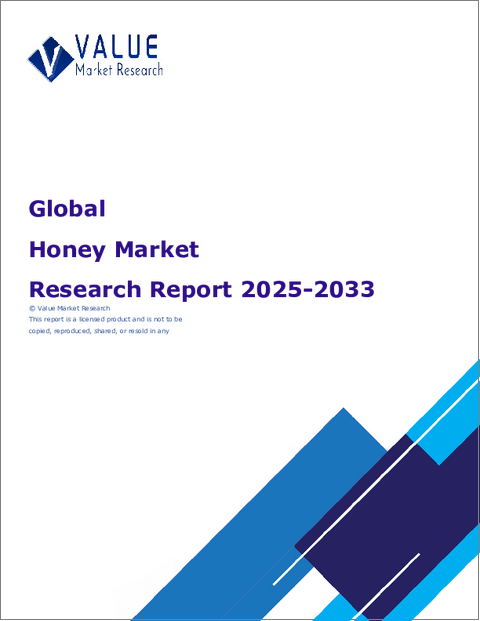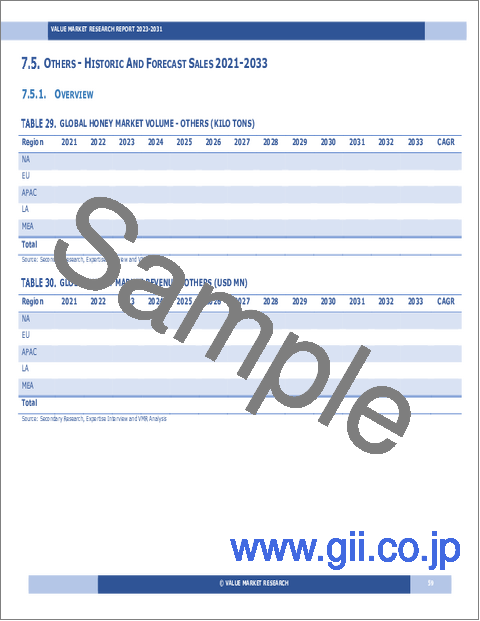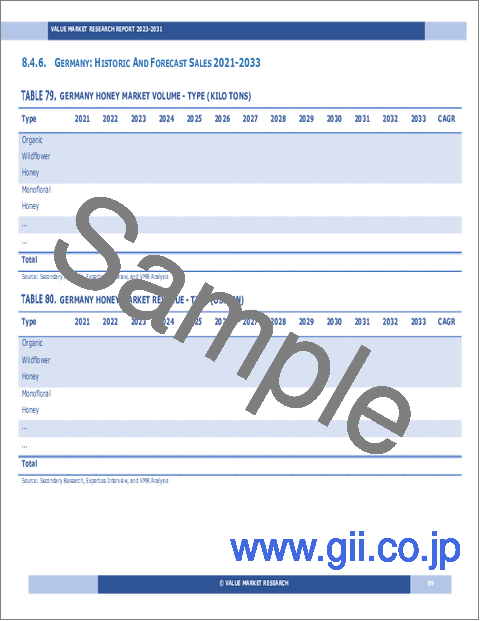|
|
市場調査レポート
商品コード
1743685
ハチミツの世界市場調査レポート:産業分析、規模、シェア、成長、動向、2025年から2033年までの予測Global Honey Market Research Report - Industry Analysis, Size, Share, Growth, Trends and Forecast 2025 to 2033 |
||||||
カスタマイズ可能
|
|||||||
| ハチミツの世界市場調査レポート:産業分析、規模、シェア、成長、動向、2025年から2033年までの予測 |
|
出版日: 2025年06月01日
発行: Value Market Research
ページ情報: 英文 196 Pages
納期: 即日から翌営業日
|
全表示
- 概要
- 図表
- 目次
世界のハチミツ市場規模は2024年の97億9,000万米ドルから2033年には150億7,000万米ドルに成長し、2026~2033年の予測期間中に4.91%の堅調な年間平均成長率(CAGR)を示すと予測されています。
ハチミツ市場は、天然甘味料や有機甘味料に対する消費者の嗜好の高まりによって、著しい成長を遂げようとしています。健康志向の人々が精製された砂糖の代替品を求める中、ハチミツは抗酸化特性や潜在的な抗炎症作用など、数多くの健康上のメリットがあるとして認知されつつあります。この消費者行動の変化は、家庭の主食としてのハチミツの地位を高めるだけでなく、様々な料理や健康食品への応用を拡大しています。職人的で地元産のハチミツブランドの台頭は、消費者が品質、トレーサビリティ、持続可能性を重視する製品に引き寄せられ、市場力学をさらに高めています。
伝統的用途に加え、ハチミツ市場は飲食品産業全体で革新的な用途への需要が急増しています。醸造プロセスにハチミツを取り入れるクラフトビールメーカーから、天然の風味増強剤としてハチミツを利用するグルメ食品メーカーに至るまで、ハチミツの多用途性がますます認識されるようになっています。さらに、栄養補助食品や機能性食品を含む健康ウェルネス製品の動向の高まりが、主要成分としてのハチミツの取り込みを後押ししています。消費者が原料の調達や製品の透明性に関して見識を深めるにつれ、倫理的プラクティスやサステイナブル養蜂を優先するブランドは、この進化する情勢において競争優位を獲得する可能性が高いです。
今後、ハチミツ市場は、ハチミツの生産効率と品質を向上させる養蜂の実践と技術の進歩から恩恵を受けると予想されます。また、ミツバチの個体数が直面している環境問題への意識の高まりは、産業内でミツバチの保護とサステイナブル実践の促進を目指したイニシアチブを促しています。消費者が購買の意思決定を自分の価値観と一致させる中、ハチミツ市場は持続的な成長を遂げる好位置にあり、高品質で倫理的に調達された製品を提供することに尽力する利害関係者に多くの機会を提供しています。
当社のレポートは、様々な産業や市場に関する包括的かつ実用的な洞察を顧客に提供するために綿密に作成されています。各レポートは、市場情勢を完全に理解するために、いくつかの重要な要素を含んでいます。
市場概要:定義、分類、産業の現状など、市場に関する詳細なイントロダクション。
市場力学:市場成長に影響を与える主要促進要因・抑制要因・機会・課題を詳細に分析します。このセクションでは、技術の進歩、規制の変更、新たな動向などの要因を検証します。
セグメンテーション分析:製品タイプ、用途、エンドユーザー、地域などの基準に基づき、市場を明確なセグメントに内訳。この分析により、各セグメントの業績と将来性を明らかにします。
競合情勢:市場シェア、製品ポートフォリオ、戦略的イニシアティブ、財務実績など、主要市場参入企業の包括的評価。主要企業が採用する競合力学と主要戦略に関する考察を記載しています。
市場予測:過去のデータと現在の市場状況に基づき、一定期間における市場規模と成長動向を予測します。これには、定量的分析と将来の市場軌跡を示すグラフ表示が含まれます。
地域分析:地域による市場パフォーマンスを評価し、主要市場や地域動向を明らかにします。地域の市場力学とビジネス機会を理解するのに役立ちます。
新たな動向と機会:現在の市場動向と新たな市場動向、技術革新、潜在的な投資対象セグメントを特定します。将来の開発と成長展望に関する洞察を記載しています。
目次
第1章 序文
第2章 エグゼクティブサマリー
- 市場のハイライト
- 世界市場スナップショット
第3章 ハチミツ産業分析
- イントロダクション:市場力学
- 市場促進要因
- 市場抑制要因
- 機会
- 産業動向
- ポーターのファイブフォース分析
- 市場の魅力分析
第4章 バリューチェーン分析
- バリューチェーン分析
- 原料分析
- 原料リスト
- 原料メーカー一覧
- 主要原料の価格動向
- 潜在的バイヤーリスト
- マーケティングチャネル
- 直接マーケティング
- 間接マーケティング
- マーケティングチャネル発展動向
第5章 ハチミツの世界市場分析:タイプ別
- タイプ別概要
- タイプ別過去・予測データ分析
- 有機野生ハチミツ
- 単花ハチミツ(フレーバーハチミツ)
第6章 ハチミツの世界市場分析:用途別
- 用途別概要
- 用途別過去・予測データ分析
- 飲食品
- パーソナルケアと化粧品
- 医薬品
- その他
第7章 ハチミツの世界市場分析:流通チャネル別
- 流通チャネル別概要
- 流通チャネル別過去・予測データ分析
- スーパーマーケット/ハイパーマーケット
- コンビニエンスストア
- オンライン小売業者
- その他
第8章 世界のハチミツ市場分析:地域別
- 地域別展望
- イントロダクション
- 北米の売上分析
- 概要、実績と予測
- 北米:セグメント別
- 北米:国別
- 米国
- カナダ
- メキシコ
- 欧州売上分析
- 概要、実績と予測
- 欧州:セグメント別
- 欧州:国別
- 英国
- フランス
- ドイツ
- イタリア
- ロシア
- その他の欧州
- アジア太平洋売上分析
- 概要、実績と予測
- アジア太平洋:セグメント別
- アジア太平洋:国別
- 中国
- インド
- 日本
- 韓国
- オーストラリア
- 東南アジア
- その他のアジア太平洋
- ラテンアメリカ売上分析
- 概要、実績と予測
- ラテンアメリカ:セグメント別
- ラテンアメリカ:国別
- ブラジル
- アルゼンチン
- ペルー
- チリ
- その他のラテンアメリカ
- 中東・アフリカ売上分析
- 概要、実績と予測
- 中東・アフリカ:セグメント別
- 中東・アフリカ:国別一覧
- サウジアラビア
- アラブ首長国連邦
- イスラエル
- 南アフリカ
- その他の中東・アフリカ
第9章 ハチミツ企業の競合情勢
- ハチミツ市場の競合
- パートナーシップ/協力/協定
- 合併と買収
- 新製品発売
- その他の開発
第10章 企業プロファイル
- 上位企業の市場シェア分析
- 市場集中度
- Barkman Honey
- Bee Maid Honey
- Beeyond The Hive
- Billy Bee Honey Products
- Capilano Honey
- Comvita
- Dabur India
- Dutch Gold Honey
- GloryBee
- Golden Acres Honey
- Little Bee Impex
- Oha Honey
- Savannah Bee Company
- Streamland
LIST OF TABLES
- Market Snapshot
- Drivers: Impact Analysis
- Restraints: Impact Analysis
- List of Raw Material
- List of Raw Material Manufactures
- Analysis By Type (Kilo Tons and USD MN)
- Organic wildflower honey Market Sales By Geography (Kilo Tons and USD MN)
- Monofloral honey (flavoured honey) Market Sales By Geography (Kilo Tons and USD MN)
- Analysis By Application (Kilo Tons and USD MN)
- Food and beverages Market Sales By Geography (Kilo Tons and USD MN)
- Personal care and cosmetics Market Sales By Geography (Kilo Tons and USD MN)
- Pharmaceuticals Market Sales By Geography (Kilo Tons and USD MN)
- Others Market Sales By Geography (Kilo Tons and USD MN)
- Analysis By Distribution Channel (Kilo Tons and USD MN)
- Supermarkets/ hypermarkets Market Sales By Geography (Kilo Tons and USD MN)
- Convenience stores Market Sales By Geography (Kilo Tons and USD MN)
- Online retailers Market Sales By Geography (Kilo Tons and USD MN)
- Others Market Sales By Geography (Kilo Tons and USD MN)
- Global Honey Market Sales By Geography (Kilo Tons and USD MN)
- North America Market Analysis (Kilo Tons and USD MN)
- United States Market Analysis (Kilo Tons and USD MN)
- Canada Market Analysis (Kilo Tons and USD MN)
- Mexico Market Analysis (Kilo Tons and USD MN)
- Europe Market Analysis (Kilo Tons and USD MN)
- Europe Market Estimate By Country (Kilo Tons and USD MN)
- United Kingdom Market Analysis (Kilo Tons and USD MN)
- France Market Analysis (Kilo Tons and USD MN)
- Germany Market Analysis (Kilo Tons and USD MN)
- Italy Market Analysis (Kilo Tons and USD MN)
- Russia Market Analysis (Kilo Tons and USD MN)
- Spain Market Analysis (Kilo Tons and USD MN)
- Rest of Europe Market Analysis (Kilo Tons and USD MN)
- Asia Pacific Market Analysis (Kilo Tons and USD MN)
- China Market Analysis (Kilo Tons and USD MN)
- Japan Market Analysis (Kilo Tons and USD MN)
- India Market Analysis (Kilo Tons and USD MN)
- South Korea Market Analysis (Kilo Tons and USD MN)
- Australia Market Analysis (Kilo Tons and USD MN)
- South East Asia Market Analysis (Kilo Tons and USD MN)
- Rest of Asia Pacific Market Analysis (Kilo Tons and USD MN)
- Latin America Market Analysis (Kilo Tons and USD MN)
- Brazil Market Analysis (Kilo Tons and USD MN)
- Argentina Market Analysis (Kilo Tons and USD MN)
- Peru Market Analysis (Kilo Tons and USD MN)
- Chile Market Analysis (Kilo Tons and USD MN)
- Rest of Latin America Market Analysis (Kilo Tons and USD MN)
- Middle East & Africa Market Analysis (Kilo Tons and USD MN)
- Saudi Arabia Market Analysis (Kilo Tons and USD MN)
- UAE Market Analysis (Kilo Tons and USD MN)
- Israel Market Analysis (Kilo Tons and USD MN)
- South Africa Market Analysis (Kilo Tons and USD MN)
- Rest of Middle East and Africa Market Analysis (Kilo Tons and USD MN)
- Partnership/Collaboration/Agreement
- Mergers And Acquisition
LIST OF FIGURES
- Research Scope of Honey Report
- Market Research Process
- Market Research Methodology
- Global Honey Market Size, By Region (Kilo Tons and USD MN)
- Porters Five Forces Analysis
- Market Attractiveness Analysis By Type
- Market Attractiveness Analysis By Application
- Market Attractiveness Analysis By Distribution Channel
- Market Attractiveness Analysis By Region
- Value Chain Analysis
- Global Market Analysis By Type (Kilo Tons and USD MN)
- Organic wildflower honey Market Sales By Geography (Kilo Tons and USD MN)
- Monofloral honey (flavoured honey) Market Sales By Geography (Kilo Tons and USD MN)
- Global Market Analysis By Application (Kilo Tons and USD MN)
- Food and beverages Market Sales By Geography (Kilo Tons and USD MN)
- Personal care and cosmetics Market Sales By Geography (Kilo Tons and USD MN)
- Pharmaceuticals Market Sales By Geography (Kilo Tons and USD MN)
- Others Market Sales By Geography (Kilo Tons and USD MN)
- Global Market Analysis By Distribution Channel (Kilo Tons and USD MN)
- Supermarkets/ hypermarkets Market Sales By Geography (Kilo Tons and USD MN)
- Convenience stores Market Sales By Geography (Kilo Tons and USD MN)
- Online retailers Market Sales By Geography (Kilo Tons and USD MN)
- Others Market Sales By Geography (Kilo Tons and USD MN)
- Global Market Sales (Kilo Tons and USD MN)
- North America Market Sales (Kilo Tons and USD MN)
- Europe Market Sales (Kilo Tons and USD MN)
- Asia Pacific Market Sales (Kilo Tons and USD MN)
- Latin America Market Sales (Kilo Tons and USD MN)
- Middle East & Africa Market Sales (Kilo Tons and USD MN)
- Recent Development in Industry
- Top Company Market Share Analysis
Kindly note that the above listed are the basic tables and figures of the report and are not limited to the TOC.
Global Honey Market size is anticipated to grow from USD 9.79 Billion in 2024 to USD 15.07 Billion by 2033, showcasing a robust Compound Annual Growth Rate (CAGR) of 4.91% during the forecast period of 2026 to 2033.
The honey market is poised for remarkable growth, driven by an increasing consumer preference for natural and organic sweeteners. As health-conscious individuals seek alternatives to refined sugars, honey is gaining recognition for its numerous health benefits, including antioxidant properties and potential anti-inflammatory effects. This shift in consumer behavior is not only elevating honey's status as a staple in households but also expanding its applications in various culinary and wellness products. The rise of artisanal and locally sourced honey brands is further enhancing market dynamics, as consumers gravitate towards products that emphasize quality, traceability, and sustainability.
In addition to traditional uses, the honey market is witnessing a surge in demand for innovative applications across the food and beverage industry. From craft breweries incorporating honey into their brewing processes to gourmet food manufacturers utilizing honey as a natural flavor enhancer, the versatility of honey is being increasingly recognized. Moreover, the growing trend of health and wellness products, including dietary supplements and functional foods, is propelling the incorporation of honey as a key ingredient. As consumers become more discerning about ingredient sourcing and product transparency, brands that prioritize ethical practices and sustainable beekeeping will likely gain a competitive advantage in this evolving landscape.
Looking ahead, the honey market is expected to benefit from advancements in beekeeping practices and technology, which can enhance honey production efficiency and quality. The increasing awareness of the environmental challenges facing bee populations is also prompting initiatives aimed at promoting bee conservation and sustainable practices within the industry. As consumers align their purchasing decisions with their values, the honey market is well-positioned for sustained growth, offering a plethora of opportunities for stakeholders committed to delivering high-quality, ethically sourced products.
Our reports are meticulously crafted to provide clients with comprehensive and actionable insights into various industries and markets. Each report encompasses several critical components to ensure a thorough understanding of the market landscape:
Market Overview: A detailed introduction to the market, including definitions, classifications, and an overview of the industry's current state.
Market Dynamics: In-depth analysis of key drivers, restraints, opportunities, and challenges influencing market growth. This section examines factors such as technological advancements, regulatory changes, and emerging trends.
Segmentation Analysis: Breakdown of the market into distinct segments based on criteria like product type, application, end-user, and geography. This analysis highlights the performance and potential of each segment.
Competitive Landscape: Comprehensive assessment of major market players, including their market share, product portfolio, strategic initiatives, and financial performance. This section provides insights into the competitive dynamics and key strategies adopted by leading companies.
Market Forecast: Projections of market size and growth trends over a specified period, based on historical data and current market conditions. This includes quantitative analyses and graphical representations to illustrate future market trajectories.
Regional Analysis: Evaluation of market performance across different geographical regions, identifying key markets and regional trends. This helps in understanding regional market dynamics and opportunities.
Emerging Trends and Opportunities: Identification of current and emerging market trends, technological innovations, and potential areas for investment. This section offers insights into future market developments and growth prospects.
SEGMENTATION COVERED IN THE REPORT
By Type
- Organic wildflower honey
- Monofloral honey (flavoured honey)
By Application
- Food and beverages
- Personal care and cosmetics
- Pharmaceuticals
- Others
By Distribution Channel
- Supermarkets/ hypermarkets
- Convenience stores
- Online retailers
- Others
- COMPANIES PROFILED
- Barkman Honey
- Bee Maid Honey
- Beeyond the Hive
- Billy Bee Honey Products
- Capilano Honey
- Comvita
- Dabur India
- Dutch Gold Honey
- GloryBee
- Golden Acres Honey
- Little Bee Impex
- Oha Honey
- Savannah Bee Company
- Streamland.
- The above list can be customized.
TABLE OF CONTENTS
1. PREFACE
- 1.1. Report Description
- 1.1.1 Objective
- 1.1.2 Target Audience
- 1.1.3 Unique Selling Proposition (USP) & offerings
- 1.2. Research Scope
- 1.3. Research Methodology
- 1.3.1 Market Research Process
- 1.3.2 Market Research Methodology
2. EXECUTIVE SUMMARY
- 2.1. Highlights of Market
- 2.2. Global Market Snapshot
3. HONEY INDUSTRY ANALYSIS
- 3.1. Introduction - Market Dynamics
- 3.2. Market Drivers
- 3.3. Market Restraints
- 3.4. Opportunities
- 3.5. Industry Trends
- 3.6. Porter's Five Force Analysis
- 3.7. Market Attractiveness Analysis
- 3.7.1 Market Attractiveness Analysis By Type
- 3.7.2 Market Attractiveness Analysis By Application
- 3.7.3 Market Attractiveness Analysis By Distribution Channel
- 3.7.4 Market Attractiveness Analysis By Region
4. VALUE CHAIN ANALYSIS
- 4.1. Value Chain Analysis
- 4.2. Raw Material Analysis
- 4.2.1 List of Raw Materials
- 4.2.2 Raw Material Manufactures List
- 4.2.3 Price Trend of Key Raw Materials
- 4.3. List of Potential Buyers
- 4.4. Marketing Channel
- 4.4.1 Direct Marketing
- 4.4.2 Indirect Marketing
- 4.4.3 Marketing Channel Development Trend
5. GLOBAL HONEY MARKET ANALYSIS BY TYPE
- 5.1. Overview By Type
- 5.2. Historical and Forecast Data Analysis By Type
- 5.3. Organic wildflower honey Historic and Forecast Sales By Regions
- 5.4. Monofloral honey (flavoured honey) Historic and Forecast Sales By Regions
6. GLOBAL HONEY MARKET ANALYSIS BY APPLICATION
- 6.1. Overview By Application
- 6.2. Historical and Forecast Data Analysis By Application
- 6.3. Food and beverages Historic and Forecast Sales By Regions
- 6.4. Personal care and cosmetics Historic and Forecast Sales By Regions
- 6.5. Pharmaceuticals Historic and Forecast Sales By Regions
- 6.6. Others Historic and Forecast Sales By Regions
7. GLOBAL HONEY MARKET ANALYSIS BY DISTRIBUTION CHANNEL
- 7.1. Overview By Distribution Channel
- 7.2. Historical and Forecast Data Analysis By Distribution Channel
- 7.3. Supermarkets/ hypermarkets Historic and Forecast Sales By Regions
- 7.4. Convenience stores Historic and Forecast Sales By Regions
- 7.5. Online retailers Historic and Forecast Sales By Regions
- 7.6. Others Historic and Forecast Sales By Regions
8. GLOBAL HONEY MARKET ANALYSIS BY GEOGRAPHY
- 8.1. Regional Outlook
- 8.2. Introduction
- 8.3. North America Sales Analysis
- 8.3.1 Overview, Historic and Forecast Data Sales Analysis
- 8.3.2 North America By Segment Sales Analysis
- 8.3.3 North America By Country Sales Analysis
- 8.3.4 United States Sales Analysis
- 8.3.5 Canada Sales Analysis
- 8.3.6 Mexico Sales Analysis
- 8.4. Europe Sales Analysis
- 8.4.1 Overview, Historic and Forecast Data Sales Analysis
- 8.4.2 Europe By Segment Sales Analysis
- 8.4.3 Europe By Country Sales Analysis
- 8.4.4 United Kingdom Sales Analysis
- 8.4.5 France Sales Analysis
- 8.4.6 Germany Sales Analysis
- 8.4.7 Italy Sales Analysis
- 8.4.8 Russia Sales Analysis
- 8.4.9 Rest Of Europe Sales Analysis
- 8.5. Asia Pacific Sales Analysis
- 8.5.1 Overview, Historic and Forecast Data Sales Analysis
- 8.5.2 Asia Pacific By Segment Sales Analysis
- 8.5.3 Asia Pacific By Country Sales Analysis
- 8.5.4 China Sales Analysis
- 8.5.5 India Sales Analysis
- 8.5.6 Japan Sales Analysis
- 8.5.7 South Korea Sales Analysis
- 8.5.8 Australia Sales Analysis
- 8.5.9 South East Asia Sales Analysis
- 8.5.10 Rest Of Asia Pacific Sales Analysis
- 8.6. Latin America Sales Analysis
- 8.6.1 Overview, Historic and Forecast Data Sales Analysis
- 8.6.2 Latin America By Segment Sales Analysis
- 8.6.3 Latin America By Country Sales Analysis
- 8.6.4 Brazil Sales Analysis
- 8.6.5 Argentina Sales Analysis
- 8.6.6 Peru Sales Analysis
- 8.6.7 Chile Sales Analysis
- 8.6.8 Rest of Latin America Sales Analysis
- 8.7. Middle East & Africa Sales Analysis
- 8.7.1 Overview, Historic and Forecast Data Sales Analysis
- 8.7.2 Middle East & Africa By Segment Sales Analysis
- 8.7.3 Middle East & Africa By Country Sales Analysis
- 8.7.4 Saudi Arabia Sales Analysis
- 8.7.5 UAE Sales Analysis
- 8.7.6 Israel Sales Analysis
- 8.7.7 South Africa Sales Analysis
- 8.7.8 Rest Of Middle East And Africa Sales Analysis
9. COMPETITIVE LANDSCAPE OF THE HONEY COMPANIES
- 9.1. Honey Market Competition
- 9.2. Partnership/Collaboration/Agreement
- 9.3. Merger And Acquisitions
- 9.4. New Product Launch
- 9.5. Other Developments
10. COMPANY PROFILES OF HONEY INDUSTRY
- 10.1. Top Companies Market Share Analysis
- 10.2. Market Concentration Rate
- 10.3. Barkman Honey
- 10.3.1 Company Overview
- 10.3.2 Company Revenue
- 10.3.3 Products
- 10.3.4 Recent Developments
- 10.4. Bee Maid Honey
- 10.4.1 Company Overview
- 10.4.2 Company Revenue
- 10.4.3 Products
- 10.4.4 Recent Developments
- 10.5. Beeyond The Hive
- 10.5.1 Company Overview
- 10.5.2 Company Revenue
- 10.5.3 Products
- 10.5.4 Recent Developments
- 10.6. Billy Bee Honey Products
- 10.6.1 Company Overview
- 10.6.2 Company Revenue
- 10.6.3 Products
- 10.6.4 Recent Developments
- 10.7. Capilano Honey
- 10.7.1 Company Overview
- 10.7.2 Company Revenue
- 10.7.3 Products
- 10.7.4 Recent Developments
- 10.8. Comvita
- 10.8.1 Company Overview
- 10.8.2 Company Revenue
- 10.8.3 Products
- 10.8.4 Recent Developments
- 10.9. Dabur India
- 10.9.1 Company Overview
- 10.9.2 Company Revenue
- 10.9.3 Products
- 10.9.4 Recent Developments
- 10.10. Dutch Gold Honey
- 10.10.1 Company Overview
- 10.10.2 Company Revenue
- 10.10.3 Products
- 10.10.4 Recent Developments
- 10.11. GloryBee
- 10.11.1 Company Overview
- 10.11.2 Company Revenue
- 10.11.3 Products
- 10.11.4 Recent Developments
- 10.12. Golden Acres Honey
- 10.12.1 Company Overview
- 10.12.2 Company Revenue
- 10.12.3 Products
- 10.12.4 Recent Developments
- 10.13. Little Bee Impex
- 10.13.1 Company Overview
- 10.13.2 Company Revenue
- 10.13.3 Products
- 10.13.4 Recent Developments
- 10.14. Oha Honey
- 10.14.1 Company Overview
- 10.14.2 Company Revenue
- 10.14.3 Products
- 10.14.4 Recent Developments
- 10.15. Savannah Bee Company
- 10.15.1 Company Overview
- 10.15.2 Company Revenue
- 10.15.3 Products
- 10.15.4 Recent Developments
- 10.16. Streamland
- 10.16.1 Company Overview
- 10.16.2 Company Revenue
- 10.16.3 Products
- 10.16.4 Recent Developments





